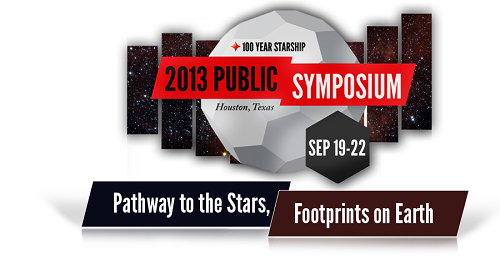My flight to Houston for the 100 Year Starship Symposium was complicated by aircraft maintenance problems, two switched flights and lost baggage (due in tonight), but I’m now ensconced in the hotel room, from which I just snapped the photo below. I’m 26 stories up and plan to go higher (to the rooftop restaurant) in a little bit.

As I did at Starship Congress, my plan is to focus my attention on taking notes and I won’t try to do any ‘live blogging’ from Houston. When I get back next week, I’ll be writing up the event over a spread of days as I try to get my notes in order. There should be plenty to talk about. Look for me on Twitter as @centauri_dreams if you’re hoping for the occasional tweet. And while I’m here, although I probably won’t be writing much on the site, I’ll take care of comment moderation as often as I can.



100 Year Starship: Interstellar Space Travel Conference Warps Into Houston This Week
by Miriam Kramer, Staff Writer | September 19, 2013 06:00 am ET
Move over, Scotty: Some real-life engineers and scientists are flocking to Houston this week to debate the future of interstellar space travel.
Members of the public, industry professionals and academics have descended upon the Texas city for the third annual 100 Year Starship symposium, which will discuss what the world needs to do in the next 100 years to take starship technology out of the realm of science fiction and into reality.
The conference started today (Sept. 19) and runs through Sunday (Sept. 22). It’s hosted by the 100 Year Starship initiative, which was started with seed money from the U.S. military’s Defense Advanced Research Projects Agency and seeks to develop a vehicle over the next century that could reach a far-off star within a reasonable amount of time.
Full article here:
http://www.space.com/22855-100-year-starship-warps-into-houston.html
September 18, 2013
Earth’s Starship Destiny — “Galactic Civilization is Almost Inevitable” (VIDEO)
We now know, says futurist Peter Schwartz, that nearly all of the billions of stars in our galaxy have planets. If we can master interstellar travel, “there’s someplace to go.” Our own solar system is pretty boring—one planet is habitable, the rest are “like Antarctica without ice” or worse.
So this last year a number of researchers and visionaries have begun formal investigation into the practicalities of getting beyond our own solar system. It is an extremely hard problem, for two primary reasons—the enormous energy required to drive far and fast, and the vast amount of time it takes to get anywhere even at high speed.
The energy required can be thought of in three ways. 1) Impossible—what most scientists think. 2) Slow. 3) Faster than light (FTL). Chemical rockets won’t do at all. Nuclear fission rockets may suffice for visiting local planets, but it would take at least fusion to get to the planets of other stars.
Schwartz showed Adam Crowl’s scheme for a Bussard Ramjet using interstellar ions for a fusion drive. James Benford (co-author of the book on all this, Starship Century) makes the case for sail ships powered by lasers based in our Solar System.
As for faster-than-light, that requires “reinventing physics.” Physics does keep doing that (as with the recent discovery of “dark energy). NASA has one researcher, John Cramer, investigating the potential of microscopic wormholes for superluminar travel.
Standard-physics travel will require extremely long voyages, much longer than a human lifetime. Schwartz suggested four options. 1) Generational ships—whole mini-societies commit to voyages that only their descendents will complete. 2) Sleep ships—like in the movie “Avatar,” travelers go into hibernation. 3) Relativistic ships—a near the speed of light, time compresses, so that travelers may experience only 10 years while 100 years pass back on Earth. 4) Download ships—“Suppose we learn how to copy human consciousness into some machine-like device. Such ‘iPersons’ would be able to control an avatar that could function in environments inhospitable to biological humans. They would not be limited to Earthlike planets.”
Full article here:
http://www.dailygalaxy.com/my_weblog/2013/09/we-now-know-schwartz-began-that-nearly-all-of-the-billions-of-stars-in-our-galaxy-have-planets-if-we-can-master-interste.html
Hey Paul,
Hope you have a great time over there – enjoy it!
Just wondering though – will this be live streamed? Would love to see this :D
thanks
Patrick, sorry to hear that 100YSS won’t be live streaming. Instead, the sessions are to be posted online in October. If I hear anything more, I’ll pass it along.
Hi Paul,
Unfortunate that the conference will not be live streamed. That technology really made recent Starship Congress available to non-attendees in real time.
Enjoy!